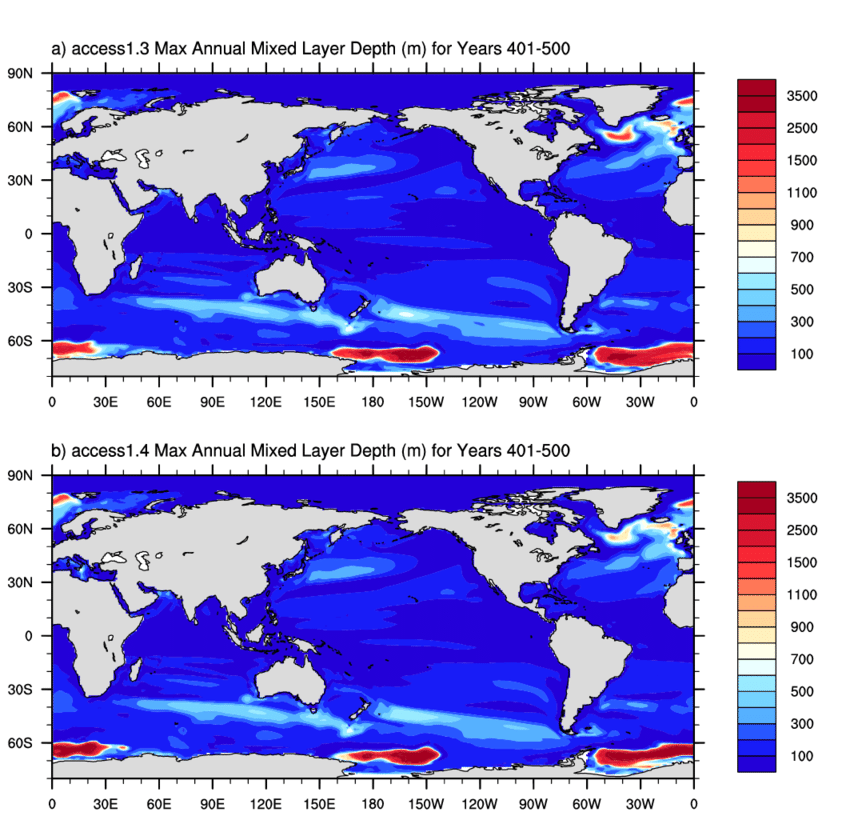ACCESS1-3 model output prepared for CMIP5 (Coupled Model intercomparison Project phase 5) of the historical experiment, ensemble r2i1p1. ACCESS1-3 is a general circulation climate model developed as a collaboration between CSIRO and BoM.
This simulation is a historical experiment, simulating the global climate between 1850-2006, using historical forcings. The ARC Centre of Excellence for Climate System Science (ARCCSS) has run this particular experiment.
This model simulation is part of the contribution of the Australian Community Climate and Earth System Simulator Coupled Model (ACCESS-CM) to CMIP5. There are two versions of the ACCESS-CM, namely ACCESS1.0 and ACCESS1.3.
ACCESS1.3 uses these components: the UK MetOffice UM atmosphere model, the GFDL MOM4p1 ocean model, the LANL CICE4.1 sea-ice model and the CABLE land surface model.
The historical experiment is a long-term simulation of the 20th century climate including all forcing: solar, volcanic, stratospheric aerosol, anthropogenic aerosol, emissions and greenhouse gas concentrations. Greenhouse gas concentrations include: CO2, N2O, CH4, CFC11, CFC12, CFC113, HCFC22, HFC125, HFC134a. The simulation cover from 1850 to 2005 and branches from the year 341 of the pre-industrial control (piControl) experiment. The ensemble member is defined by a triad of integers describing a specific initial condition (r), initialisation method (i), and perturbed physics version (p). These are valid only in the contest of a specific model, so r2i1p1 will have same initialisation and physics scheme as the ACCESS1-3 r1i1p1 simulations but different initial condition.
Refer to the CMIP5 official website for more information on the definition of historical experiments and naming of ensembles.
The simulation raw output goes through the following steps after production: post-processing, quality control and publishing. The first two are performed for these simulations by the ARCCSS data manager.
Post-processing from raw to CMIP5 data, using software written in python scripting language developed by Peter Uhe (Collier, M. and Uhe, P. 2012), this uses the Climate Model Output Rewriter (CMOR2) library Version 2 supplied to the community by PCMDI.
Quality control of CMIP5 data, there are three levels:
QC1 data and metadata compliance checks automatically imposed by CMOR2 and the Earth System Grid data publishing software;
QC2 data consistency checks using the QC L2 tools described at https://redmine.dkrz.de/projects/cmip5-qc/wiki/Qc_level_2;
QC3 extended checking of data and metadata by the World Data Centre for Climate.
The ACCESS CMIP5 datasets have passed the level 1 and 2 quality control checks.
The CMIP5 data is published and archived on the Earth System Grid , available at the National Computing and Infrastructure (NCI) National Facility.
Each variable is stored in separate netcdf files grouped in the following subsets:
"day" for daily data;
"Amon" for atmospheric monthly data;
"Omon" for ocean monthly data;
"OImon" for sea-ice monthly data;
"Lmon" for land monthly data;
"LImon" for land ice monthly data;
"aero" for aerosol monthly data.
For more information on the model configuration refer to:
Dix, M., Vohralik, P., Bi, D., Rashid, H., Marsland, S., O'Farrell, S., Uotila, P., Hirst, T., Kowalczyk, E., Sullivan, A., Yan, H., Franklin, C., Sun, Z., Watterson, I., Collier, M., Noonan, J., Rotstayn, L., Stevens, L., Uhe, P. and Puri, K., The ACCESS couple model: documentation of core CMIP5 simulations and initial results, Aust. Met. Oceanogr. J., 63, 83-99, 2013;
and to the ACCESS CMIP5 wiki.
For more information on the ACCESS CMIP5 datasets and parameters:
Collier, M. and Uhe, P. 2012. CMIP5 datasets from the ACCESS1.0 and ACCESS1.3 coupled climate models. CAWCR Technical Report No. 059.








